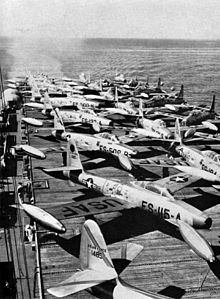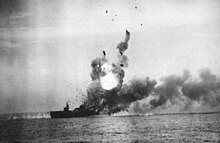Casablanca class
| Casablanca class | |
|---|---|
 USS Guadalcanal (CVE-60) 1944 |
|
| Overview | |
| Type | Escort aircraft carrier |
| units | 50 |
| Namesake | Casablanca |
| 1. Period of service |
|
| period of service |
1943-1964 |
| Technical specifications | |
| displacement |
7800 ts (standard) |
| length |
156.2 m |
| width |
32.9 m |
| height |
34.5 m (mast) |
| Draft |
6.9 m |
| crew |
860 |
| drive |
4 piston steam engines, 9000 HP on two propellers |
| speed |
19 kn |
| Range |
10,200 nm at 15 kn |
| Armament |
|
| Planes |
28 |
The Casablanca-class was a class of escort aircraft carriers of the US Navy . With 50 ships completed at Kaiser Shipyards between April 1943 and June 1944 , the Casablanca-class is the numerically strongest class of aircraft carriers of all time. The carriers, originally designed as escort ships for North Atlantic convoys , were used in all theaters of war during the Second World War . During the Korean War , some units were used as aircraft transporters. One ship, Thetis Bay , was converted into a helicopter carrier.
history
Planning and construction
The precarious situation of the US Navy after the loss of four fleet carriers in 1942 and the threat to the supply convoys to Great Britain from German submarines required the rapid construction of new aircraft carriers. The industrialist and shipyard owner Henry J. Kaiser therefore promised US President Franklin D. Roosevelt the delivery of no less than 50 escort carriers within one year. Kaiser presented precise plans for how he wanted to build a large number of escort carriers for the US Navy within a very short time at his shipyard on the Columbia River in Vancouver , Washington , using the same mass production methods as the Liberty freighters . Kaiser was awarded the contract to build the girders; the first, the Casablanca , was laid down on November 3, 1942. The launch took place on April 5, 1943, after almost five months of construction. The commissioning with the US Navy took place on July 8, 1943, just eight months after the keel was laid. The last ship of the class, the Munda , entered service on July 8, 1944, exactly one year after the first ship. The construction time on the slipway was shortened over the course of time from five to only two months, the entire construction time was in some cases only a little more than three months. Sometimes there were only five to seven days between the launching of the individual ships. Unlike other aircraft carriers which was in some ships of the Casablanca-class naming ceremony performed by female employees and workers of the shipyard.
units
The names of the ships were often changed before the keel was laid, and the original plan to hand over 25 of the 50 ships to the Royal Navy was dropped because the US Navy needed the porters itself.
Use and whereabouts
Although originally planned and built as escort ships for convoys in the Atlantic, many of the carriers were also used in the Pacific theater of war, where they were involved in many carrier operations. One of the most important missions of carriers of the Casablanca class was the battle of Samar , when an association consisting of six escort carriers and his escorts stopped the Japanese armed forces, which were far superior in numbers and strength, and forced them to turn back.
After the war, the carriers were decommissioned very quickly, the main reason being the outdated technology of the propulsion system and the low top speed of only 19 knots. During the Korean War, however, some Casablanca-class carriers in reserve were reactivated and used as aircraft transporters manned by civilian crews. The USS Thetis Bay was converted into a helicopter carrier in 1955 and remained in service in this role until 1964, five years longer than any other ship in the class. Except for the Makassar Strait , which was sunk as a target ship in 1958, all carriers of the class were scrapped by 1961.
losses
Five Casablanca-class carriers were lost to enemy action during World War II. The Liscome Bay sank on 24 November 1943, after a torpedo hit a Japanese submarine before Butaritari . During the Battle of Samar, Gambier Bay was badly damaged by Japanese gunfire and sank on October 25, 1944. Three porters fell victim to Kamikaze attacks: the St. Lo on October 25, 1944 during the sea and air battle in the Leyte Gulf who have favourited Ommaney Bay on January 4, 1945 in the Sulu Sea and the Bismarck Sea on February 21, 1945 off Iwo Jima .
technology
hull
The carrier's fuselage was based on the Maritime Commission's S4-S2-BB3 type , but was designed from the outset for use as an aircraft carrier. The ships were 149.35 meters long and 19.9 meters wide at the waterline. The overall length was 156.2 meters, the maximum width 32.9 meters. The flight deck was 12.5 meters above the waterline, the bridge 18.3 meters and the top of the mast 34.5 meters. The draft was 6.9 meters, the displacement was 7800 standard tonnes empty and 10,400 standard tonnes loaded. The ships had no armor, only a light splinter protection was present. The construction turned out to be very susceptible to strong rolling movements in rough seas , which is why the bulk of the Casablanca-class ships were withdrawn from the North Atlantic again after a short time from their submarine tasks .
drive
The Casablanca-class carriers were the first major warships since the HMS Dreadnought that were not powered by steam turbines. Since there were supply bottlenecks for gearboxes and important turbine parts due to the war, it was decided to use piston steam engines . The carriers were each driven by four five-cylinder direct current steam engines from the Skinner Engine Company, which operated on two shafts with one propeller each. The steam was generated in four boilers with a pressure of 31 bar and a steam temperature of 400 ° C. With a total output of 9,000 hp , the top speed was 19 knots. The fuel supply of 2113 tons enabled a range of 7200 nautical miles at top speed, at 15 knots the range was 10,200 nautical miles.
Armament and Electronics
The carriers had only light anti-aircraft armament; a single 127 mm cannon, 38 caliber length, was mounted at the stern below the flight deck . The other armament consisted of 16 40-mm guns in twin arrangement and 20 20-mm Oerlikon cannons .
The carrier's main radar was either the General Electric SC radar with a range of up to 60 nautical miles or the SK radar with a range of up to 100 nautical miles. In the course of the war, the ships were then additionally equipped with a system for friend-foe recognition , the antenna of which was located on the radar antenna. To locate surface targets, the ships had an SG radar from Raytheon with a range of up to 22 nautical miles, which could also be used to a limited extent for locating aircraft. The antenna was a little below the top of the mast.
Flight deck and aircraft
The flight deck was connected to the hangar deck below by two aircraft elevators. On the deck, a compressed air-powered aircraft catapult was available on the port side for the aircraft to take off. For the landings, nine safety cable systems and three “crash barriers” were available on board , which were supposed to stop the landing aircraft if the safety cables were missed. Were on board the carrier to 28 aircraft (a so-called "composite squadron") are housed, usually there were 16 F4F Wildcat - fighter planes and 12 TBM Avenger - torpedo bomber for antisubmarine warfare on board. But SBD Dauntless - dive bombers were partly used from aboard the carrier.
Additional information
literature
- Stefan Terzibaschitsch : US Navy aircraft carrier . Bernard & Graefe Verlag, Bonn 2001, ISBN 3763762000 .
Web links
- Casablanca class at hazegray.org (English)
- Casablanca class at globalsecurity.org (English)
Footnotes
- ↑ Terzibaschitsch: aircraft carrier of the US Navy. P. 33f
- ↑ a b c Terzibaschitsch: aircraft carrier of the US Navy. P. 204ff
- ↑ a b Terzibaschitsch: aircraft carrier of the US Navy. P. 214f
- ↑ candotg.org ( Memento of August 28, 2008 in the Internet Archive ), as of February 3, 2009
- ↑ candotg.org: USS Guadalcanal Initial Operations ( Memento of August 28, 2008 in the Internet Archive ), as of May 14, 2008
- ↑ Terzibaschitsch: Combat systems of the US Navy . Koehler Verlagsgesellschaft, Hamburg, 2001, ISBN 3-7822-0806-4 . P. 93f
- ↑ Terzibaschitsch: Combat systems of the US Navy . P. 99
- ↑ Terzibaschitsch: Combat systems of the US Navy . P. 97




